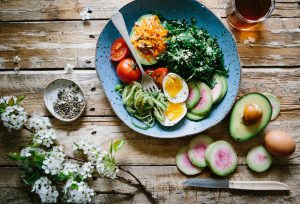 How Can I Control Candida and Re-Balance My Body?
How Can I Control Candida and Re-Balance My Body?
There is no denying Candida is difficult to control and it requires commitment and patience. Candida thrives on sugar and refined carbohydrates, however if you stay light-hearted and focused, with time you can conquer this imbalance. Heck, you might even shed a few kilos in the process of giving up sugar, wheat other refined items. #Wining
Please first see Candida Overgrowth blog post to identify symptoms involved with this imbalance to see if you think you may be experiencing this gut imbalance.
Modern medicine tends to treat Candida with Nystatin, which has mixed results. Like any medication, Nystatin will only help alleviate symptoms and will not address the underlying cause for the yeast overgrowth. Through cutting sugar and freeing your-self of sugar cravings the Candida diet helps one become more in tune with our body and enjoy the benefits of strengthening our digestive and immune systems. We stop craving blood sugar fixes and start craving foods that our body innate needs and wants. Many people report that they discover an array of new menu items all of which support a healthier lifestyle.
 Let’s Look At a Candida Specific Diet.
Let’s Look At a Candida Specific Diet.
The Candida diet is a low-sugar, anti-inflammatory diet that promotes good gut health and eliminates the sugars that feed a Candida overgrowth. The diet includes non-starchy vegetables, some low sugar fruits, non-glutenous grains, some dairy products, and fermented foods (which we will discuss in a moment). Generally though in the first few days when denying the body sugar and wheat, there is often an increase of cravings and symptoms so set yourself up to win by following these guidelines:
- Eat plain, full fat acidophilus yoghurt every day.
- Taking acidophilus and bifida supplements twice day. The use of probiotics is very important to re-establish intestinal flora. Preferably both gluten and casein free (Seeking Health’s Probiota Woman and Metagenics Ultraflora Plus are good examples).
- It is very important to keep water intake high, for flushing the toxins out the body.
- Garlic is a fabulous natural antifungal herb which you should try to consume daily. It is recommended that eating half a clove twice a day, raw and fresh is highly beneficial. Take this just before a meal or just after taking wheat or barley concentrates. Don’t consume garlic at the sometime as your probiotic as they become counter effective.
- Focus on simple food combinations.
- Chlorophyll is purifying and stops the spread of bacterial. It also promotes the growth of beneficial intestinal flora. Therefore barley and wheat grass (which contain significant amounts of chlorophyll) are perhaps the most effective at treating yeasts. These work best as powders or tablets rather than juices, which are sweeter. Kelp and other seaweeds are also highly recommended. Parsley, kale, collard and dandelion greens, watercress, cabbage, and spirulina are all helpful.
- According to “Healing with Whole Foods, Oriental Traditions and Modern Nutrition”, if the tongue coating is thick, greasy, or yellow, this indicates the need for cleansing of accumulated mucus in the digestive tract. Author Paul Pitchford recommends consuming one to two ounces of ‘button’ or other mushrooms, about three ounces of daikon radish or three or four red radishes daily.
- Certain herbs are also known to be very helpful in controlling candida. The herb “pau d’arco” is apparently excellent and two other bitter herbs, “chaparral” and “burdock” are also beneficial. Your naturopath, homeopath or chiropractor should be able to order these for you or help you locate another point of purchase.
- For longstanding relief from candida, it is imperative to ensure that your bowel is receiving efficient and correct nerve messages from your central nervous system. With the correct anti-candida diet, chiropractic adjustments support your body to regain balance and build immune strength.
- Homeopathy may also help with re-balancing the body. A homeopath will discuss with you your symptoms and best match a remedy. Some of these may be Calc Carb, Nettle, Rhus Tox, or Sulphur.
Candida Dietary Protocol – Foods To Eat:
- Organic Meats: chicken, beef, lamb, fish, pork, turkey (unprocessed)
- Fish: salmon, sardines, mackerel, herring, and anchovies are highest in Omega 3 essential fatty acids. Other fish are fine except for tuna and shark.
- Eggs
- Organic Vegetables: lots of green vegetables (Organic avoids pesticides and chemicals) Asparagus, Brussels sprouts, cabbage, broccoli, kale, celery, cucumber, eggplant, onion, spinach, zucchini, cauliflower, tomatoes, and rutabaga (best if eaten raw or steamed).
- Good fats: Raw unprocessed nut butters or nuts (esp. macadamia), almonds, sunflower seeds, pumpkin seeds, coconut or flaxseed oil, olive oil, nut flours in moderation (as tolerated)
- Cooking oils: ghee (casein & lactose free), coconut oil, meat fats. Ghee and coconut oil contain small and medium chain fatty acids which are anti-fungal and provide good energy sources for the body.
- All legumes (beans, peas, and lentils) are fine, aduki beans are known to be helpful with drying damp conditions and mung beans are detoxifying. Navy (white or haricot) beans or chickpeas as hummus (soak beans first.)
- Grain substitutes (as tolerated): Grains that are wheat-free such as buckwheat, sorghum, millet, amaranth, quinoa, oats, barley, and rice are allowed. Ensure that any purchased breads made from these products are both yeast and wheat-free. Naturally leavened, whole-grain sourdough rye bread may be used.
- Dairy substitutes: nut milks, coconut milk/cream, rice milk (occasionally), coconut yoghurt (only organic very low sugar brands with minimal additives!)
- Fruit: berries (may be eaten in small amounts), lemon, limes
- Sweeteners: Xylitol or liquid stevia
- Herbs: Black pepper, salt, cinnamon, dill, garlic, ginger, oregano, rosemary, paprika, turmeric and thyme.
- Eat plenty of raw, unsalted sauerkraut mixed with garlic, seaweed, and cabbage.
- Fermented soy products such as miso, tempeh, tofu can be tolerated in small amounts.
Eliminate The Following Foods:
- All sugars & sugar containing foods including sugar, fructose, agave, glucose, coconut sugar or coconut nectar, mannitol, sorbitol, lactose, honey, maple syrup, jams, Nutella, molasses, date sugar, barley malt, rice syrup, artificial sweeteners & chocolate.
- Packaged and processed foods, fast foods, artificial flavours, colours & preservatives, soft drinks, alcohol. Packaged and processed foods usually contain refined sugar products; artificial flavours, colours, and sweeteners; MSG in the form of hydrolysed vegetable protein, autolyzed yeast, yeast extract, maltodextrin; and processed vegetable oils.
- Bread and Baked goods containing yeast.
- Cheese, Milk & other dairy products.
- Grains and flours: cereals, rice, corn, and all gluten grains including wheat, bulgar wheat, barley, spelt, oats, kamut, triticale.
- Yeast, mould, fungi foods including mushrooms, dried fruit, peanuts, cashews, pecans and pistachios, corn, edamame.
- Processed and smoked meats: Pickled and smoked meats and fish, including bacon, ham, salami, sausages (except organic with no preservatives), hot dogs, corned beef, smoked salmon. Additives: Nitrates or sulfates.
- Processed vegetable oils for cooking e.g. Soybean, canola, safflower, rice bran, margarine.
- Fruit: best to eliminate all fruit as it’s high in sugar, especially fruit juice, dried fruit, bananas, dates, grapes, melons & tropical fruit; berries are ok in moderation as are lemons & limes.
- High starch vegetables: white potatoes, parsnip, sweet potatoes, beets.
- Vinegar and condiments including barbeque, chilli, Worcester, and fish sauces; soy and tamari, tomato sauce/ketchup (except organic without additives), pickles, horseradish, relishes, mustard, packaged mayonnaise, and salad dressing; vanilla extract (except alcohol free or vanilla powder).
- Caffeine, alcohol, and sugary beverages: Caffeinated teas, coffee, energy drinks, soda, fruit juice, beer, wine, or spirits.
I can feel you panicking, wondering what the heck can you eat?!?
Here are some meal ideas to help get you started…
Breakfast: include protein and healthy fats – and veggies if possible!
- Eggs e.g. Boiled, scrambled, fried in coconut oil or ghee.
- Frittata or omelette made with chopped or pureed vegetables
- Millet toast with avocado, boiled egg, or cashew butter
- Chicken or meat patties (include grated vegetables!)
- Sausages – chicken, beef, or lamb (NO fillers – ask organic butcher for meat only)
- Pancakes with coconut or buckwheat flour & nut milk (add blueberries if tolerated)
- Bacon occasionally (nitrate free)
- Smoothies with nut milks &/or coconut yoghurt
- Broths: If having chicken or meat broth, have ¼ cup before/with protein breakfast.
- Juices: vegetable juice best before protein breakfast.
Lunches & Dinners: include protein, healthy fats & vegetables
- Meatballs/meatloaf/hamburger: ground beef, lamb, pork, or chicken
- Stews/casseroles/mild curries – any meat or chicken
- Roasted or slow cooked pulled meats (low heat preferable)
- Salmon baked, grilled or gently pan fried
- Frittatas or omelettes made with chopped or pureed vegetables
- Stir fried meat/chicken & vegetables (ghee, coconut oil)
- Soups: Chicken/meat and /or vegetable soup (vegetable puree often more appealing)
- Vegetable starches: cauliflower rice/mashed; butternut squash; zucchini ‘noodles’; vegetable pancakes.
- GF wrap or sandwiches with approved fillings.
- Salads or Poke bowls
Nutrient Dense Snack Foods:
- Chicken legs/pieces
- Sausage or meatballs
- Hardboiled eggs
- Hummus & seed crackers
- Vegetable sticks – e.g. carrot, celery
- Kale chips (preferably homemade)
- Carrot, zucchini, or parsnip fries/chips
- Coconut yoghurt (need to keep cold!)
- Muffins (homemade with approved ingredients)
- Salmon (sustainable tinned or in jars)
- Avocado eaten with sea salt & spoon
- Nori veggie wraps with shredded veggies and/or meat
- Organic blueberries or strawberries in bowl with organic coconut yoghurt
- Organic raw nuts: macadamias, cashews, hazelnuts (small handful x 2-3 a week)
- Organic coconut chips, pumpkin seeds, or sunflower seeds
- Homemade protein balls
- Chocolate protein smoothie -1 cup almond, coconut or cashew milk blended with 1-2 teaspoons raw cacao or carob powder, plus optional ¼ avocado
Keep the focus on what you CAN eat, rather than what you are cutting out. Chin up, consistency is the key. You can do it! Your gut will be back in balance soon enough and you can slowly reintroduce other foods.
If you would like to learn more about Candida please see our second blog on this topic…. We also have a number of blogs on gut health, here is a link to our Leaky Gut blog…
. . . . .  Yours in Health,
Yours in Health,
Jennifer Barham-Floreani
(Bach. Chiropractic, Bach. App Clinical Science Registered internationally, no longer practicing as a chiropractor in Australia.)
. . . . .
Want to learn more about how to live a healthy lifestyle? For more health-related information, please see Well Adjusted Babies 2nd Edition.
References:
Candida Diet: The Foods & Supplements to Eat (and Avoid) to Treat Candida. Dr Josh Axe. https://draxe.com/health/
Holistic Treatment for Candida Infection. Joe Mercola https://articles.
How Yeast Can Create Havoc in Your Life and How to Address it. Joe Mercola https://articles.
Pitchford P. Healing with Whole Foods. Asian Traditions and Modern Nutrition. California: North Atlantic Books;2002.
Salmon J. Pearce L. Autism & Attention Deficit Disorders. Bangor; Persimmon Press: 2006.
Sullivan K. Natural Healthcare for Children. London; Judy Piatkus: 2000.
Lipski E PhD. Digestive Wellness For Children. Laguna Beach; Basic Health Publications: 2006.
Mercola J Dr. Pearsall K Dr. Take Control of Your Health. Schaumburg; Mercola.com: 2007
Updated: March 30, 2021






